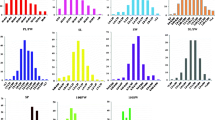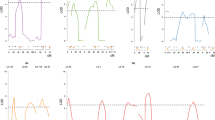Abstract
An attempt was made to identify quantitative trait loci (QTLs) for several productivity and plant architecture traits in a full-sib progeny of 144 individuals from two non-inbred parents in cassava. A molecular linkage map of this cross constructed previously with over 250 markers was the source of molecular markers. The progeny were grown under field conditions at two locations (Palmira and Quilichao) in Colombia and evaluated in 2 years (1998 and 1999) for architecture and productivity traits. Architecture traits evaluated were plant height (PH), branching height (BH), branching levels (BL), branching index (BI), stem portion with leaves (SPL) and leaf area index (LAI). Productivity traits were those related to total dry matter production and distribution, namely fresh root yield (FRY), fresh shoot yield (FSY), harvest index (HI) and the number of storage roots (NR). Phenotypic evaluation of the traits in this population revealed continuous variation for all traits. Broad-sense heritability estimates, ranged from 36% (for NR) to 94% (for BH). Several significant phenotypic correlations were observed between architecture and productivity traits. Primary QTLs, using the single-QTL model, and secondary QTLs, by a primary QTL interaction model, were detected by interval mapping. A total of 30 primary QTLs and 84 secondary QTLs were detected. We identified 35% of detected QTLs in two or more trials, the other QTLs were environment-specific. These results underscore the significant genotype × environment interactions found for most of the traits. Several genomic segments affecting multiple traits were identified and were in agreement with correlation among traits. All QTLs identified for FRY were found associated with either component traits of productivity or architecture traits. This study suggests that QTLs for plant architecture can be used to improve productivity. However an exhaustive search and analysis of QTLs controlling architecture is required before marker-assisted selection (MAS) for increasing productivity can be initiated.
Similar content being viewed by others
References
Barua UM, Chalmers KJ, Thomas WTB, Hackett CA, Lea V, Jack P, Forster BP, Waugh R, Powell W (1993) Molecular mapping of genes determining height, time to heading and growth habit in barley (Hordeum vulgare). Genome 36:1080–1087
Bryne M, Murell JC, Owen JV, Kriedemann P, Williams ER, Moran GF (1997) Identification and mode of action of quantitative trait loci affecting seedling height and leaf area in Eucalyptus nitens. Theor Appl Genet 94:674–681
Bryne PF, McMullen MD, Wiseman BR, Snook ME, Musket TA, Theuri JM, Widstrom NW, Coe EH (1998) Maize silk maysin concentration and corn earworm antibiosis: QTLs and genetic mechanisms. Crop Sci 38:461–471
CIAT (1975) Annual report. CIAT Cali, Colombia
Chen SG, Ceulremans R, Impens I (1994) Is there a light regime-determined tree ideotype? Theor Biol 169:153–161
Chen FQ, Foodlad MR, Hyman J, St.Clair DA, Beelaman RB (1999) Mapping of QTLs for lycopene and other fruit traits in a Lycopersicum esculentum × L. pimpinefolium cross and comparison of QTLs across tomato species. Mol Breed 5:283–299
Cochran WG, Cox GM (1957) Experimental designs, 2nd edn. John Wiley and sons Inc, New York, pp 396–438
Cock JH (1985) Cassava: new potential for a neglected crop. Westview Press Inc, Boulder, Colorado
Cock JH, El-Sharkawy MA (1988) Physiological characteristics for cassava selection. Exp Agric 24:443–448
Cock JH, Franklin D, Sandoval G, Juri P (1979) The ideal cassava plant for maximum yield. Crop Sci 19:271–279
De Vincente MC, Tanksley SD (1993) QTL analysis of transgressive segregation in an interspecific tomato cross. Genetics 134:585-59
Doerge RW, Churchill GA (1994) Empirical threshold values for quantitative trait mapping. Genetics 138:963–971
Donald CM (1968) The breeding of crop ideotypes. Euphytica 17:385–403
Farnsworth KD, Niklas KJ (1995) Theories of optimization, form and function in branching architecture in plants. Functional Ecol 9:355–363
Fehr WR (1987) Principles of cultivar development. Theory and technique, vol 1. Macmillan publishing company, New York, pp 247–260
Foodlad MR, Chen FQ, Lin GY (1998) RFLP mapping of QTLs conferring cold tolerance during seed germination in an interspecies cross of tomato. Mol Breed 4:519–529
Fregene MA, Angel F, Gomez R, Rodriguez F, Roca W, Tohme J, Bonierbale M (1997) A molecular genetic map of cassava (Manihot esculenta Crantz). Theor Appl Genet 95:431–441
Gruneberg H (1998) An analysis of the "pleiotropic" effects of a new lethal mutation in the rat (Mus norvegius). Proc R Soc Lond B 125:123–144
Hershey C, Jennings D (1992) Progress in breeding cassava for adaptation to stress. Plant Breed Abstracts 62:823–831
Hunt LA, Wholey DW, Cock JH (1997) Growth physiology of cassava (Manihot esculenta Crantz). Field Crops Abstracts 30:77–91
Iglesias CA, Calle F, Hershey C, Jaramillo G, Mesa E (1994) Sensitivity of cassava (Manihot esculenta Crantz) clones to environmental changes. Field Crops Res 36:213–220
Johnson HW, Robinson HF, Comstock RE (1955) Estimates of genetic and environmental variability in soybeans. Agron J 47:314–318
Lander ES, Botstein D (1989) Mapping Mendelian factors underlying quantitative traits using RFLP linkage maps. Genetics 126:735–742
Lenis JI, Calle F, Jaramillo G, Perez JC, Ceballos H, Cock JH (2003). The effect of leaf retention in cassava productivity (submitted to Crop Sci)
Lian TS, Cock JH (1979a) Branching habit as a yield determinant in cassava. Field Crops Res 2:281–289
Lian TS, Cock JH (1979b) Cassava plant forms and their associated and their associated morpho-physiological characters. MARDI Res Bull 7,2:55–69
Lin H-X, Quian H-R, Zhuang J-Y, Lu J, Min S-K, Xiong Z-M, Huang N, Zheng K-L (1996) RFLP mapping of QTLs for yield and related characters in rice. RGN 12:251–253
Lin SY, Sasaki T, Yano M (1998) Mapping quantitative trait loci controlling seed dormancy and heading date in rice, Oryza sativa L., using backcross inbred lines. Theor Appl Genet 96:997–1003
Lincoln S, Daly M, Lande E (1992) Mapping genes controlling quantitative traits with MAPMAKER/QTL 1.1. Whitehead Institute Technical Report, 2nd edn. Whitehead Institute, Cambridge, Massachusetts
Liu BH, Lu YY (1995) PGRI, a software for plant genome research. Plant Genome III Conference Abstract, P 105
Mba REC, Stephenson P, Edwards K, Melzer S, Nkumbira J, Gullberg U, Apel K, Gale M, Tohme J, Fegene M (2001) Simple sequence repeat (SSR) markers survey of the cassava (Manihot esculenta Crantz) genome: toward an SSR-based molecular genetic map of cassava. Theor Appl Genet 102:21–31
Mutschler MA, Doerge RW, Liu SC, Kuai JP, Liedl BE, Shapiro JA (1996) QTL analysis of pest resistance in the wild tomato Lycopersicum pennellii: QTLs controlling acylsugar level and composition. Theor Appl Genet 92:709–718
Nelson JC (1997) Q-gene: software for marker-based genome analysis and breeding. Mol Breed 3:229–235
Nweke FI, Dixon AGO, Asiedu R, Folayan SA (1994) Cassava varietal needs of farmers and the potential for production growth in Africa. COSCA working paper 10
Okogbenin E, Fregene M (2002) Genetic analysis and QTL mapping of early root bulking in an F1 population from non-inbred parents in cassava (Manihot esculenta Crantz). Theor Appl Genet 106:58–66
Paterson AH, Lander ES, Hewitt JD, Peterson S, Lincoln SE, Tanksley SD (1988) Resolution of quantitative traits into Mendelian factors, using a complete linkage map of restriction fragment length polymorphisms. Nature 335:721–726
Paterson AH, Deverna JW, Lanini B, Tanksley SD (1990) Fine mapping of quantitative trait loci using selected overlapping recombinant chromosomes, in an interspecies cross of tomato. Genetics 124:7.35–742
Paterson AH, Damon S, Hewitt JD, Zamir D, Rabinowitch HD, Lincoln SE, Lander ES, Tanksley SD (1991) Mendelian factors underlying quantitative traits in tomato: comparison across species, generations, and environments. Genetics 127:181–197
Perreira MG, Lee M (1995) Identification of genomic regions affecting plant height in sorghum and maize. Theor Appl Genet 90:380–388
Rami JF, Dufour P, Trouche G, Fliedel G, Mestres C, Davrieux, Blanchard P, Hamon P (1998) Quantitative trait loci for grain quality, productivity, morphological and agronomical traits in sorghum (Sorghum bicolor L. Moench). Theor Appl Genet 97:605–616
Rosen R (1967) Optimality principles in biology. Plenum Press, New York
SAS Institute Inc (1996) SAS/STAT software: changes and enhancement for release 6.12. Cary, North Carolina, SAS Institute Inc
Sills GR, Bridges W, Al-Janabi SM, Sorrel BWS (1995) Genetic analysis of agronomic traits in a cross between sugarcane (Saccharin officinarum L.) and its presumed progenitor (S. robustrum Brandes & Jesw. ex Grassl.). Mol Breed 1:355–363
Shapiro SS, Wilk MB (1965) An analysis of variance test for normality (complete samples). Biometrika 52:591–611
Shrimpton AE, Robertson A (1988) The isolation of polygenic factors controlling bristle score in Drosophila melanogaster. II. Distribution of third chromosome bristle effects within chromosome sections. Genetics 118:445–459
Verhaegen D, Plomion C, Gion JM, Poitel M, Costa P, Kremer A (1997) Quantitative trait dissection in Eucalyptus using RAPD markers. 1. Detection of QTLs in interspecific hybrid progeny, stability of QTL expression across different ages. Theor Appl Genet 95:597–608
Weller JI, Soller M, Brody T (1988) Linkage analysis of quantitative traits in an interspecific cross of tomato (Lycopersicon esculentum × Lycopersicon pimpinellifolium) by means of genetic markers. Genetics 118:329–339
William CG (1998) QTL mapping in outbreed pedigrees. In: Patterson AH (ed) Molecular dissection of complex traits, pp 81–94
Wu R (1993) Simulated optimal structure of a photosynthetic system; implication for the breeding of forest-crop ideotype. Can J For Res 23:1631–1638
Wu RL (1998) Genetic mapping of QTLs affecting tree growth and architecture in Populus: implication for ideotype breeding. Theo Appl Genet 96:447–457
Young SD (1999) A cautiously optimistic vision for marker-assisted breeding. Mol Breed 5:283–299
Zhuang J-Y, Lin H-X, Lu J, Qian H-R, Hittalmani, Huang N, Zheng K-L (1997) Analysis of QTL × environment interaction for yield components and plant height in rice. Theor Appl Genet 95:799–808
Acknowledgements
We are grateful to William Roca (CIAT), and H. Ceballos (CIAT) for their support, and to F. Calle, J. Bedoya, J. Valencia and J.A. Lopez for help with field experiments. This research was supported by grant from the Rockefeller Foundation to EO
Author information
Authors and Affiliations
Corresponding author
Additional information
Communicated by H. C. Becker
Rights and permissions
About this article
Cite this article
Okogbenin, E., Fregene, M. Genetic mapping of QTLs affecting productivity and plant architecture in a full-sib cross from non-inbred parents in Cassava (Manihot esculenta Crantz). Theor Appl Genet 107, 1452–1462 (2003). https://doi.org/10.1007/s00122-003-1383-0
Received:
Accepted:
Published:
Issue Date:
DOI: https://doi.org/10.1007/s00122-003-1383-0




